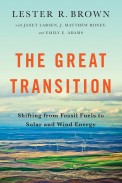Thursday, December 08, 2011
So, what have we been up to this past year to promote our plan for saving civilization? That's what this blog and the next will discuss.
| “World on the Edge details the vice closing around us: a quadruple squeeze of global warming and shortages in food, water and energy. Then it explains the path out—and how little time we have left to take that path. Got anything more important to read than that?” —Peter Goldmark, former CEO of the International Herald Tribune |
During the first six months of the year, the research team was focused on issues relating to food scarcity. It began with the release in early January of World on the Edge: How to Prevent Environmental and Economic Collapse. One of its main themes is the food production bubble, which has been created by unsustainable practices including overpumping aquifers, overplowing land, and overloading the atmosphere with carbon dioxide. The question is not whether the food bubble will burst but when.
The book received many favorable reviews, including Ed Crooks of the Financial Times, who called it “a provocative primer on some of the key global issues that businesses will face in the coming decades.”
In addition to posting a comprehensively endnoted edition of World on the Edge on EPI’s website and the immense database supporting the analyses, the research team developed two PowerPoint presentations relating to the book. The first focused on the food bubble, with the second an overview of the key topics and data. EPI’s PowerPoint presentations and data are some of the most downloaded items from the Institute’s website.
| “No one is better informed than Lester Brown of the multi-faceted crisis facing our planet. And no one has spelt out so clearly how our civilisation could be saved from falling 'over the edge' while there is—hopefully—still just time.’” —John Rowley, People and Planet |
Spinoff articles from the book quickly followed, most relating to the food issue. In rapid succession, Lester wrote “The 2011 World Food Crisis,” which Foreign Policy posted on its website. The LA Times Syndicate released “World One Poor Harvest from Chaos” in early March. The Guardian issued two articles by Lester, one in January entitled “Will climate change burst the global 'food bubble'?” and one in April entitled “This will be the Arab world's next battle" referring to water shortages. Meanwhile, the Washington Post published “Can the United States Feed China?” in its Outlook section in March, which was followed by his op-ed, “When the Nile Goes Dry,” in the New York Times in June.
Of special note was a piece Foreign Policy requested he write for its May/June issue on food. His was the cover article, entitled “The New Geopolitics of Food.” The article made three “top news” of the week lists: the Daily Beast, Mother Jones, and Business Insider. It also received more Facebook “likes” than any other Foreign Policy article in 2011: nearly 11,000 likes compared to the next highest of some 7,000. Even Lester’s January article that was posted online garnered 4,666 likes—more than most of Foreign Policy’s other articles.
The Plan B film which aired nationwide on PBS the end of March brought EPI’s work to the attention of Playboy. Shortly after it aired, Lester got a call from an editor at Playboy asking if he could write a piece for the magazine on the failing states issue. The article, entitled "Failed States," ran in the September issue.
The second half of the year, the research team examined energy issues, such as the Keystone XL pipeline, the $50 million gift by Michael Bloomberg to the Sierra Club for its Beyond Coal campaign, and the drop in carbon emissions in the United States from 2007 to 2011.
| “The world is a much more hopeful place because of the work and life of Lester Brown. World on the Edge should be read by everyone who wants to see a better life for their children, which is just about everybody.” —Ted Glick, Chesapeake Climate Action Network |
With October the month when world population would top 7 billion, reporters began contacting the Institute. Brigid Fitzgerald Reading wrote an Eco-Economy Indicator, “World Population Hitting 7 Billion” that was picked up in a number of places and triggered additional media calls. Meanwhile, two articles by the Associated Press and Reuters quoting Lester packed the Institute’s clipping service with close to 600 online articles as of the end of October. Television interviews included Associated Press, Canadian Broadcasting, Canadian TV, and NBC Nightly News. The NBC segment aired not only on the evening program, but the next morning on the local affiliate followed by the weekend program. We also posted a blog discussing this milestone.
Throughout 2011, the team maintained a flow of Plan B Updates, Eco-Economy Indicators, Book Bytes, and Data Highlights—nearly one a week. Twelve Plan B Updates were released, 11 Book Bytes, and three Eco-Economy Indicators (temperature, population, and solar power). A few of the 12 Data Highlights that were released received particular attention, perhaps because of the unusual nature of the material, such as “Growing Goat Herds Signal Growing Grassland Decline,” “Demographics Loom Large in State Failure,” and “Learning From China: Why the Existing Economic Model Will Fail.”
We release all of our information via our listserv as well as posting them for free on our website. As our researchers are busy working on new articles, if you aren't already subscribed on our listserv or RSS feeds, you might want to do so now.
Next blog: our outreach effort.
Cheers,
Reah Janise Kauffman
Page 1 of 1 pages


